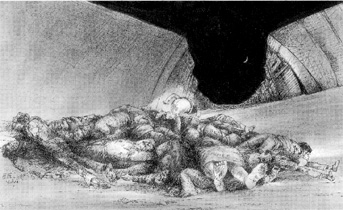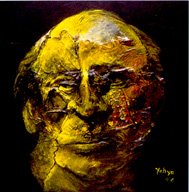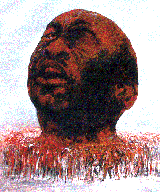May, 1999, by Samia A. Halaby
The May 1999 show at Darat Al-Funun in Jordan is made up of
sets of graphic works and paintings. The images are variations on
the theme of tyranny and oppression. In one set of nineteen ink drawings,
we see heaps of massacred humanity. At each heap there is a small
event which crowns the horror. For example a figure in screaming
anguish, or a woman holding a baby and gesturing for help, or an old man
pulling a dead youth out of the heap, or a youth pulling an old man, or
two children walking away, or a face staring out of the pile at the crescent
moon is the event dramatized by the background of horror.
In one of them an oversized truck runs over the mass of dead bodies as took place
in the massacre at Sabra and Shatila camps. Hanging at one end of the set
is one work which is most powerful. In it two old women, etched
like African sculptures in a Picasso-like manner, stand with faces of wild
tigers and arms dangling helplessly over a heap of dead. Over this
entire scene is a set of thick heavily entwined roots with
nasty fingers probing the dead to suck their juices.
In Yahya’s work there is no nobility. These are
not specific pictures of particular events. Rather, these paintings
are expressions of an idea of tyranny. To create this, Yahya standardized
his forms and indulged in a detailed illusion of distortion, disintegration,
and decay.
Most of the paintings are in grays with color reserved
for blood and floral offerings. In these paintings, the martyred dead
lie heavily on the backs of the pathetic crowd. Two notable sets
of paintings enhance the show, One is of faces in pain and the other
is of faces of Tyrants in decay. Yahya creates an illusion of the
mucky color and texture which articulate the giant heads of tyrants.
His skill is apparent in the totally visual differentiation between the
loathsome faces of the tyrants and the painful expression in the heads
of victims.
At first one is frightened at the depressing truth that
seems to be revealed. An aimless pathetic existence intermingled
with depression and defeat. Those who find the fright unbearable
will replace it with anger, which then they probably will direct at the
artist. Others might accept that this is one face of the current
state of retreat in the Arab World and courageously continue their inspection.
It is justified to wonder if this is painting at the
leading edge. The questions to be asked are those of how we see society
and not of how we understand avant-garde painting. These are painting
of social commentary. Yahya allows us to decide the precise parameters
of who the tyrant is and who the oppressed.
There are but a few symbols of a national nature to identify
the characters. But the allusions are clearly to the Arab World and
there is no mistaking the oppression of Palestinians by Israelis in this
work. We see a consistently depressing scene with only a whimper
of resistance. The rich heroism of the Palestinian refugee camp is
absent. Only the pain of life of those who suffer is presented.
Thus, the work is narrowly focussed in attitude and content.
The graphic work is in all respects more successful
than the painting. Both rely on the history of painting of social
commentary. To his credit, Yahya seems to be aware of the historical
currents in social realism. Many such allusions to this history are
visible in his work including particularly the work of Heironymus
Bosch, Francisco Goya, and Kathe Kollwitz. His references and his
expressive ambitions are international.

Select from the following menu representing the entire studio:
My Grandmother...
The Town of Beisan...
The Arab City of Jerusalem...
Sabah Told Me...
My Home in Yafa...
Khader Told Me...
Olives of Palestine...
Our Students...
A Taxi Ride in Bethlehem...
Written by Doctor Fathiye Saudi...
Hasan Told Me...
A Visit to Kafr Qasem...
The artist of Kafr Qasem...
The Massacre at Kafr Qasem (not yet ready)
Rana Bishara, painter, intallation artist...
Tayseer Barakat, painter...
Sari Khouri, painter...
Abdel Tamam, painter...
Vera Tamari, ceramist and painter...
Adnan Yahya, painter and graphic artists...


